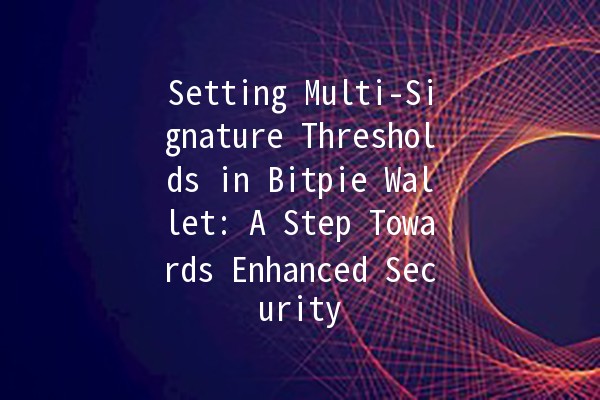




The world of cryptocurrency is everevolving, with security concerns always at the forefront. One of the most efficient ways to enhance your crypto wallet's security is by setting multisignature (multisig) thresholds in wallets like Bitpie. This article will guide you through the process, offering practical tips and insights on handling multisignature settings effectively.
Multisignature refers to a digital signature scheme that requires more than one key to authorize a transaction. In simpler terms, it is a safety feature that mandates multiple signatures from different wallets before any assets can be moved. For example, if your wallet has a 2of3 multisignature setup, two out of three designated addresses must sign a transaction for it to be valid.

Begin by downloading the official Bitpie Wallet application from the authentic source.
Install the application following the onscreen instructions.
Open the app and select the option to create a new wallet.
Make sure to follow the prompts carefully, ensuring you create a strong password and back up your recovery phrase securely.
Navigate to the settings section within the wallet interface.
Locate the multisignature option—often found under security settings.
Select the number of required signatures (threshold) and the total number of keys (cosigners).
For instance, in a 2of3 configuration, you would need two signatures from three possible keys.
You can invite cosigners either through their existing wallet addresses or by generating new ones.
After configuring your settings, confirm them and save the changes.
Make sure to communicate with your cosigners about their roles and responsibilities.
With these steps, your Bitpie wallet is now set up for enhanced security. However, knowing how to leverage this feature effectively is crucial for maximizing security.
Description: Regular audits of who has access to the multisignature wallet can help secure it further.
Implementation: Set a quarterly review schedule to assess the necessity of each cosigner's access. Remove any that are no longer relevant.
Description: Ensure all cosigners understand the backup procedures for their keys.
Implementation: Create a shared document that outlines steps for recovering access to keys, should any cosigner lose theirs.
Description: Time lock features in multisig wallets can prevent immediate transactions.
Implementation: Implement a waiting period for large withdrawals, which must be approved by cosigners. This reduces impulsive decisions.
Description: Use transaction alerts to monitor activities within your wallet.
Implementation: Configure notifications for incoming and outgoing transactions, ensuring every cosigner is updated on wallet activity.
Description: A wellinformed team is an asset for security.
Implementation: Host monthly security training or discussions that review tactics for avoiding phishing scams and other threats.
If a cosigner loses their private key, access to the multisignature wallet could be compromised. If you set up a 2of3 multisignature, you can still operate the wallet with the remaining cosigners. However, it is crucial to have a recovery plan in place, such as requiring more than just one or two keys for the maximum security of your assets.
Yes, most wallets allow you to change your multisignature configuration. However, doing so might require transitioning to a new wallet address or reinviting cosigners, making it essential to plan adjustments carefully. Always track these changes, as they could affect your transaction processes.
Multisignature wallets generally support popular cryptocurrencies like Bitcoin and Ethereum. However, their compatibility can vary based on the wallet provider. Ensure to check if your desired cryptocurrency is supported before proceeding with multisignature setup.
Transaction fees for multisignature wallets often depend on the network congestion at the time of sending. Each signature might add a slight increase to the fees; however, this could be minimal compared to the significant security benefits gained by using a multisignature setup.
While many wallets (including Bitpie) allow uniform multisignature requirements, some advanced setups might allow for varying thresholds based on the amount or type of transaction. It's crucial to refer to your specific wallet's capabilities to understand potential flexibility.
If one cosigner refuses to approve a transaction, it depends on the multisignature agreement in place. For a 2of3 setup, if two cosigners continue to approve, the transaction can proceed. It underscores the importance of clear communication among cosigners.
Setting up multisignature thresholds in your Bitpie wallet is a significant move towards securing your cryptocurrency assets. By following the outlined strategies and productivity tips, you can create a robust security framework for handling transactions. Always stay informed about the latest security practices and maintain an open dialogue with your cosigners to ensure your shared wallets remain secure.